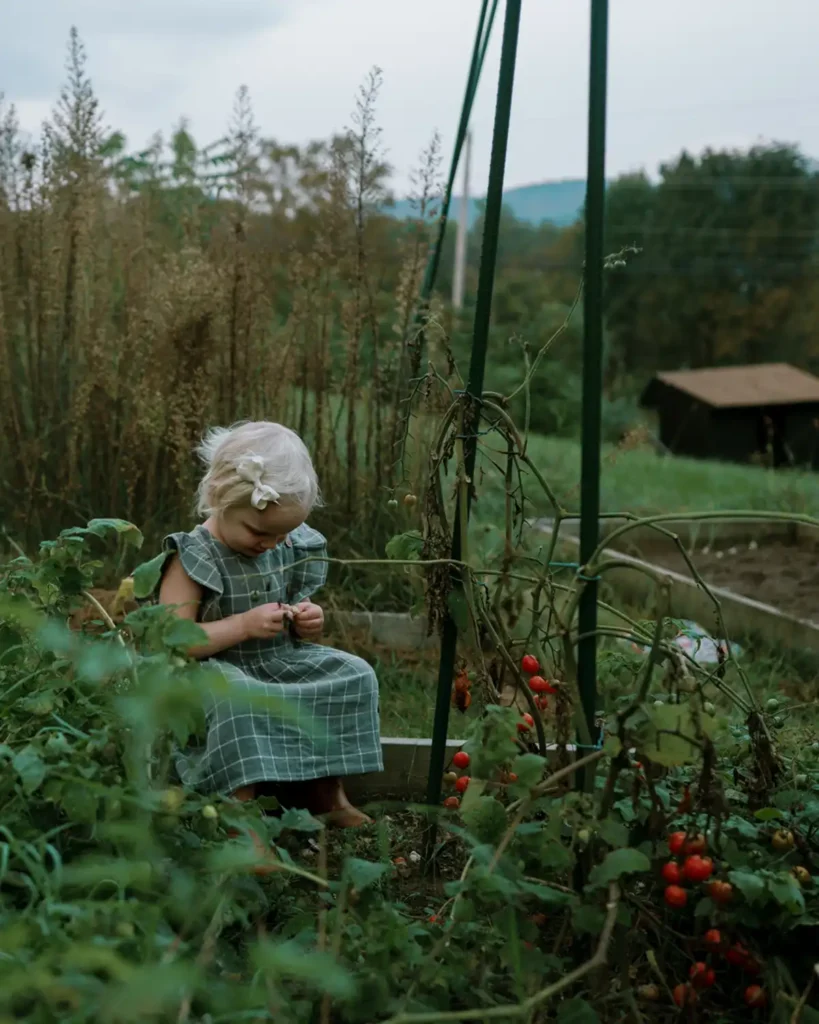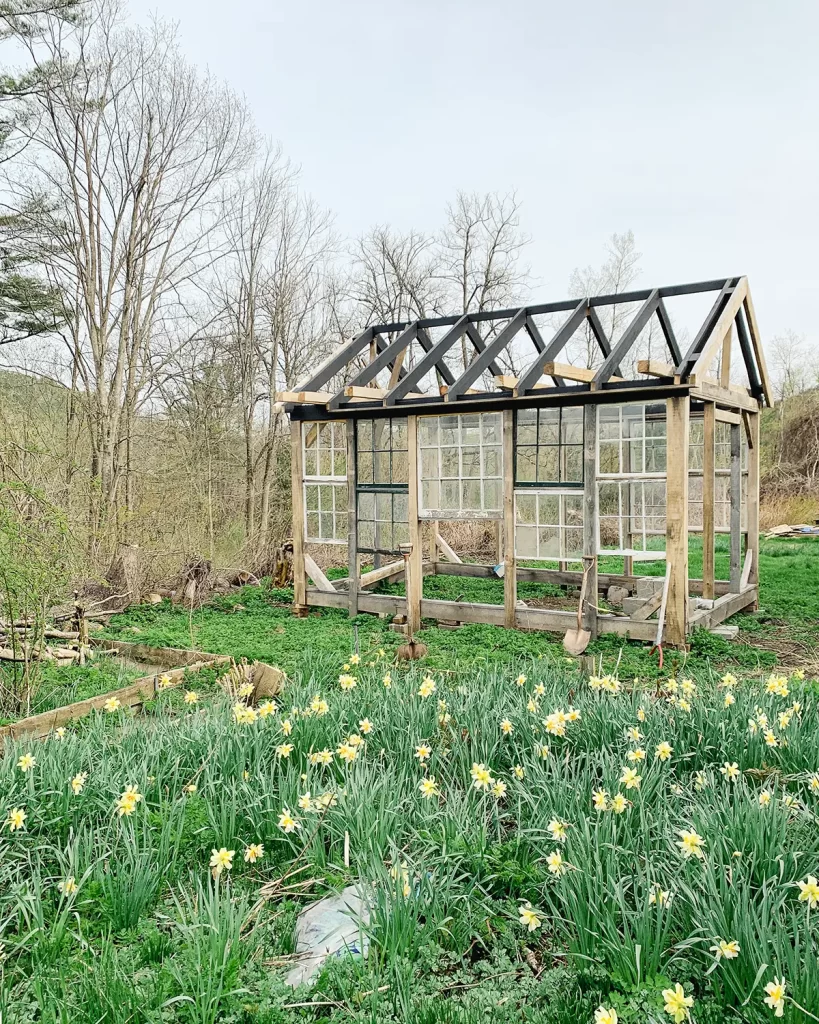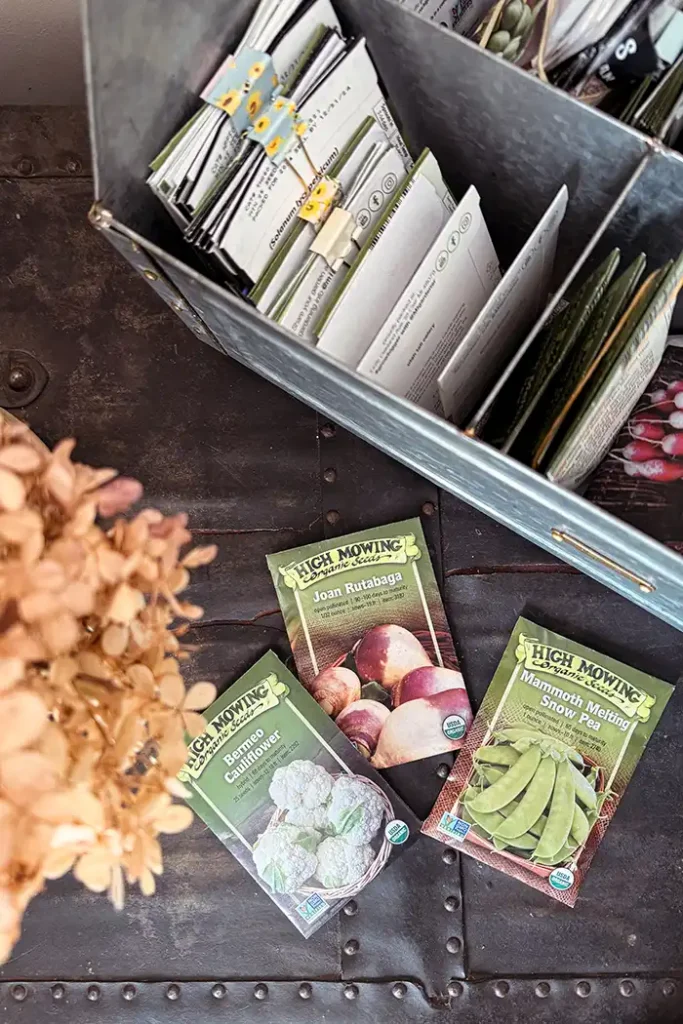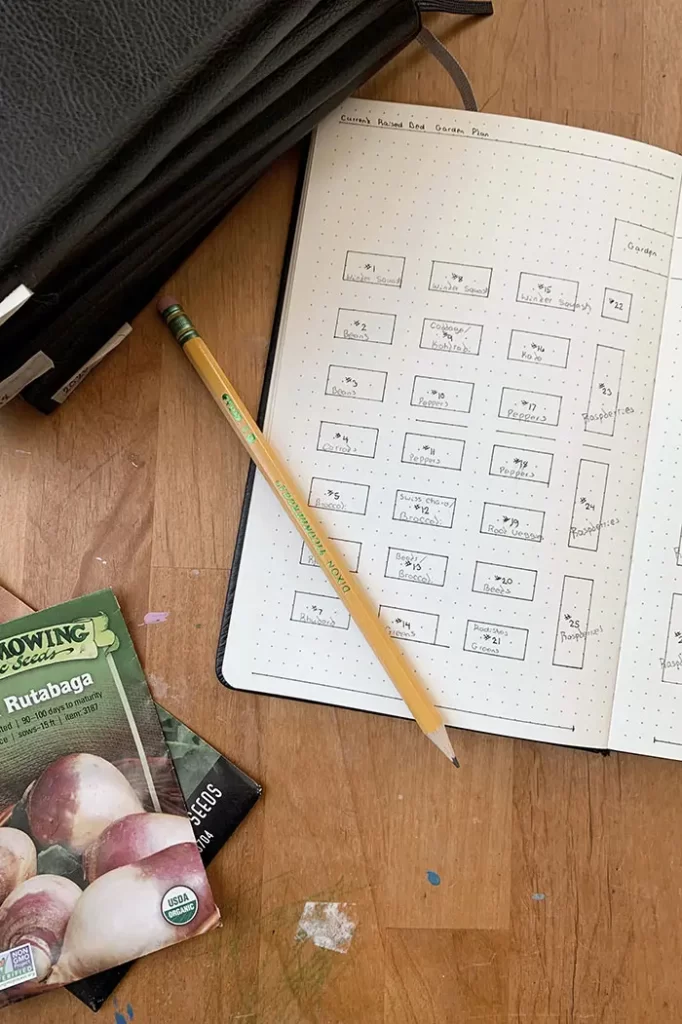Growing our own food is important to our family. We’ve been doing it for years, slowly expanding our garden space year after year. But lately, I’ve felt the tension of wanting a smaller garden instead of our large traditional garden. I’m jonesing for a kitchen garden. But what is a kitchen garden?
Oh boy do I have words (and words and words and words) to share with you about kitchen gardens.

What Is A Kitchen Garden?
A kitchen garden is typically a smaller garden space focused on fresh eating. It’s a garden with a wide variety of vegetables and is typically tended daily, a little at a time. Think radishes tucked in with salad greens next to swiss chard under compact cherry tomato plants. Plants added here and there, a little bit at a time as other vegetables are harvested.
Kitchen gardens are full of not only fresh fruits and vegetables but also flowers to help attract pollinators and other edible plants. It’s kind of like a victory garden meets flower garden with a side of potager gardens.
The basic premise of the kitchen garden is that it is a small garden space, near the kitchen door, that can be shopped from regularly for cooking meals. There may not be 100 green bean plants but 10 of one variety and a dozen of another variety.
When Rowan was one, we had a small kitchen garden right behind our house which later morphed into a monstrosity. I blame pandemic food security anxiety. Here’s the one shot I found of it, as I was cleaning up the garden in the fall. Note to self, take more pictures of the garden.

What A Kitchen Garden Is Not
A kitchen garden isn’t large with endless rows of vegetables. I would consider that type of garden a traditional vegetable garden. There is nothing wrong with those gardens. They’re a good choice for someone focused on volume food production and processing.
A large vegetable garden is great, but a lot of work compared to a small kitchen garden. Speaking from experience here. For the last few years, I’ve spent most of my daylight hours, beginning in the early spring, seed starting, transplanting, weeding, watering, and harvesting our 1200 square feet of growing space. There was so much garden space and SO much work.
With that amount of space, and filling it on the regular, it was not only hard to keep up with but also difficult to eat that much food. We were constantly behind on harvesting, canning, freezing, and fresh eating. It was hard to catch a break from the garden in the summer months, especially balancing gardening with quality time spent with the kids.
Example…my overgrown standard vegetable garden the summer our youngest was born.

A Kitchen Garden Is A Small Garden
While someday I probably will go back to a large, main vegetable garden for food production, right now I’m full-on embracing the small garden amidst my kitchen garden era.
To grow a kitchen garden, you don’t need a lot of space. No large plots or acreage are needed. You need a small, sunny spot to put down roots. Quite literally. A kitchen garden could be a compact space between a driveway and a fence, or maybe it’s tucked beside the back patio. It’s all about finding a tiny bit of square feet to dig into the soil and grow food for the kitchen.
It could also be a small plot in a community garden. Many communities offer allotments. Even our small, rural Vermont town does.
When you incorporate raised beds and trellises into a garden, it’s amazing how much fruit and veggies you can pack in even a small space. One of our favorites is eating fresh raspberries straight from the garden.

A Kitchen Garden Focuses On Fresh Easting
Think culinary garden and backyard grocery store in terms of cultivating a kitchen garden. It’s all about the magic of stepping outside your door to snip fresh herbs to put on tonight’s pasta dinner or snapping off fresh leafy greens by the patio for a late-lunch summer salad.
When your focus is on fresh eating you don’t need rows and rows of tomatoes. Think about what your family eats and what grows well in the different periods of the long growing season. Start with some radishes and spinach for spring salads, moving to shishito peppers and zucchini for roasting in the summer, and spaghetti squash to make a veggie-filled carbonara in the fall.
It doesn’t take a lot of space to grow fresh produce when you’re regularly harvesting and replacing it with seedlings. I’ve found a good rule of thumb for our family, is to start a tray or two of seeds every weekend. I’m always cracking open the seed packets throughout the entire garden season, not just in the spring.
It’s also about letting the children sit in the garden and eat cherry tomatoes and ground cherries at snack time. Bonus points if they’re barefoot!

A Kitchen Garden Is Located Near The Kitchen
One of the pillars of a kitchen garden is an easy-access location, preferably just outside the back door or near the kitchen. You’ll be harvesting from a kitchen garden regularly, often multiple times per day, so you want it as close as possible. It’s the smallest farm-to-table distance. From the backyard to the kitchen table.
I have one section of my current vegetable garden that I loathe. It’s far from the house, difficult to water because hoses don’t quite reach it, and it just looks messy and unkempt. When you cultivate a beautiful, compact kitchen garden with an ornamental aspect, you’re not going to want to hide it far from the home. It becomes part of the beauty and aesthetic of your property.
Here’s the patch of garden that’s productive yet unattractive most of the season, especially in the fall when plants are dying off from the nighttime frosts. But do you see that beautiful warty pumpkin?!

Instead of messy rows planted in the ground, a kitchen garden has beautiful raised beds mixed with large pots of trellised tomatoes and containers of fresh herbs. Or maybe it has nasturtiums vining on an arched arbor with an assortment of leaf lettuce varieties nearby.
A Kitchen Garden Is Beautiful
One of the distinct differences between a kitchen garden and a vegetable garden is that kitchen gardens are beautiful spaces. While yes, a standard vegetable garden with rows planted directly in the ground is also beautiful, kitchen gardens are next-level beautiful. They are a place you want to hang out and spend as much time as possible, beyond the time spent cultivating the vegetable patch.
Flower beds are intermingled with the carrots and nasturtiums share a space with the snow pea trellis. Or maybe compact and ornamental fruit trees are potted in a gorgeous terracotta pot next to a raised bed.
While a regular vegetable garden, small farms, and homesteads focus on food production, the kitchen garden combines that food production aspect on a smaller scale in a much more beautiful setup.

Hallmarks Of A Kitchen Garden
As I’ve pored over images of kitchen gardens and potager gardens in preparation for building our own, I’ve found they consistently include five key characteristics. While not necessary for your own kitchen garden, they add to the charm and beauty of the space.
Raised Bed Garden
Many kitchen gardens include raised beds. Some raised beds are pretty basic while others have more interesting shapes or designs. But generally, a kitchen garden includes raised beds laid out in a pattern or grid.
Raised beds in a garden are also a great way to make gardening easier. They’re more convenient to tend, pick, and plant since you’re not kneeling on the ground.
If set up correctly, they offer good drainage for the garden and can have well-balanced soil from the start. It can take years of adding organic matter to course-correct sandy soils in an in-ground vegetable plot.

Trellises And Structures
Adding trellises or other garden structures adds so much visual interest to a beautiful kitchen garden. Think arched trellises forming green tunnels between garden beds or a unique tomato trellis that is a functional work of art.
Adding trellises to a garden bed is the easiest way to expand food production in less space. You’re simply growing up.
Garden Paths
Another hallmark of the kitchen garden is the inclusion of garden paths. While the gardens are small, there is some structure and flow in how the garden is set up and organized.
The possibilities for creating garden paths depend on the space allotted and any other constraints on your home garden. But those constraints become lovely limitations that make your own garden uniquely you.
Maybe it’s just four raised beds in a grid. Or perhaps it’s L-shaped beds at the corners of your garden with a large round bed made from a stock tank sitting in the middle.
Even the paths themselves are beautiful features like brick paver garden paths or crushed rock.
Borders
Adding a beautiful and functional border around the kitchen garden is another key characteristic of a kitchen garden. Borders help define the space for growing your own food vs. the rest of your landscape.
Some favorite kitchen garden border ideas go beyond basic wire fences and include adding brick walls, creating an edible border with blueberry bushes or cherry tomatoes, adding a fragrant border with flowers, or a functional border with raised garden beds.

Sitting Area
Adding a sitting area is another bonus, although not necessary, characteristic. Some gardens may be so small that there isn’t room for garden seating. Others may have plenty of space for a lounge chair or a small bistro table tucked in a corner.
I currently have a small table and chairs in my traditional vegetable garden and it’s a favorite space to hang out, make notes in my garden journal, or simply sit and enjoy my coffee while the garden (and my family) is waking up.
Why I’m Turning Our Vegetable Garden Into A Kitchen Garden
Now that we’ve defined “what is a kitchen garden?” let’s move on to why I’m turning our large vegetable garden into a small kitchen garden. Spoiler alert, it’s complicated like a Ross and Rachel relationship.
It’s Just Too Big
I called Colby the other day while he was traveling to a job site and told him, “You’re right, the garden is too big.” Silence. I thought he was driving through a dead zone and was like, “Hello? Hello? Are you there God? It’s me, Margaret.” He responded, “Yeah, I’m here, just in shock.”
Colby has been telling me for years that my garden is too big. He’s not wrong, I’ve just been in denial because I want it big. If I were in a different season of life, the garden size would be fine. I would spend my days growing, picking, and processing the vegetables we grew.
But in this season of tending not only a garden but also small children and a budding business, it’s hard to balance it all. I’ve been feeling the tension for a while and feel like this year is the year I let it go. A little.
Enter exhibit one, my overgrown, weedy garden from last summer complete with beds I never planted. Because A) it rained every day and B) my garden space is just too big.

Design Flaws
When we first laid out our current vegetable garden grid made primarily of 4′ x 8′ raised beds, we didn’t put too much thought into location and layout. But as I’ve spent countless hours tending the garden, there are some flaws that I would like to fix.
First, the garden needs to be fenced. We deal with a plethora of critters, the worst offenders being our dog and the groundhogs. Honestly, if Merle digs up my onion seedlings one more time (insert empty threat). Just kidding we love our dog. The groundhogs, on the other hand, we do not love and they annihilate my spring greens each year.
I would love to fence our garden but because it’s so large, it would cost us more money than we care to spend. A fence also doesn’t fit well because the garden is so close to a few trees.
The other major design flaw is beds located too close together. There’s not enough room for the garden cart to maneuver down rows and it’s also difficult to mow.

A Season Of Easy
Here’s the point of the blog post where I wax poetic for a hundred words or so. Hang with me. Or skip this part if you’re not into that sort of thing.
Maybe it’s the season of life or being amidst a hardcore momming era, but I’m ready for easy. I feel like I’ve hustled in every season of life and at this point, I’m tired. More play and less hard work.
I want gardening to be fun and easy again. These last few years, ever since our second was born, it’s been HARD to keep up with the garden. I could pull it off when I was a mom of one, although it was hard even then.
Last summer, in particular, the hobby that I loved of growing our food became a burden. I constantly fell behind and the record-breaking rain didn’t help.
I also set myself up for failure with a garden space that was too big combined with a full life bursting at the seams. There was not endless time for gardening. Downsizing the garden it is!
So anyway…do you want to hear my plans for making the garden more manageable this summer?!

Very General Kitchen Garden Plans
Here is where we’re going to get wild and crazy. Hold on to your hats! The plan:
- Build a small garden complete with raised beds, paths, arbors, etc. in the space between the greenhouse and the driveway (pictured above)
- Plant the vegetables in this new kitchen garden this season
- Spend the summer reconfiguring our current large vegetable garden into a smaller kitchen garden
- Next summer plant vegetables in the newly renovated space behind the house
- Also next summer turn the garden space by the greenhouse into a cut-flower garden
And scene. Did you follow?! Am I crazy?! Yes and yes is the appropriate answer.
Rearranging garden beds is only possible during garden season here in Vermont. Our winters are just too cold and snowy to do it any other time than late spring through early fall. That means rendering our current garden unusable for a season. I can’t handle that, my soul requires digging in the dirt. Hence the building of a new garden space by the greenhouse.

We planned to always turn the space by the greenhouse into a cut flower garden. With this plan, we’ll build the structure of that garden but it will become our vegetable plot for this summer’s gardening season.
Now, if it would only stop snowing so we can finish the work on the greenhouse and start creating a beautiful new garden space.
Pssst…Seriously with the snow. I love snow. Snow is great. Don’t get me wrong. I just don’t love a 12″-18″ snowstorm at the end of March when I want to garden! True story, storm incoming as I’m writing this post. Happy spring!
Psssssst…All the photos of our family in the garden are from Kristy Burrell Photography. I am forever grateful for the photos she takes for our family each fall. 10 out 10 recommend her.
Pssssssssst…Also, there’s a tiny part of me who wants one more year of gardening in our old space to crush it so I can take photos to remember what the space looks like well taken care of. I’m so sad I don’t have pics of when it was lush, weedless, and stunning. But overextending myself this summer for the sake of photos doesn’t make things easier!





Oh Angie, how I wish we could be friends in real life and talk about gardening! I love this post. I did wonder though how you managed to eat the boatloads of food you were growing! Lol. I live in SC and started seeds inside this year and will be transplanting them soon. I like to think I’ll have a kitchen garden but it’s not exactly close to my kitchen. You have to go out the back door and through the pool area to get to the not fancy and unromantic line of raised beds we have setup. Considering I had zero room in our old yard in PA to have a garden, my rather plain row of boxes makes me quite happy. Anyway, I look forward to seeing your progress on this project! I’m sure it will be fabulous! We are building a pool house this summer for guests (never mind the headache that has been). You can come visit and help
me with my little garden! :). Also I bust out laughing when you mentioned Are you there God? It’s me Margaret. I remember that book! Too funny!
Yes! I was wondering if anyone would pick up on the Judy Blume reference! Oh my, don’t tease about warmer temps, garden talk, and helping with a garden. I’ll be right there! A pool house sounds dreamy. Ha! Keep me posted on your garden updates, I love garden talk.
Love this! I want to create a small kitchen garden off our back deck. Following.